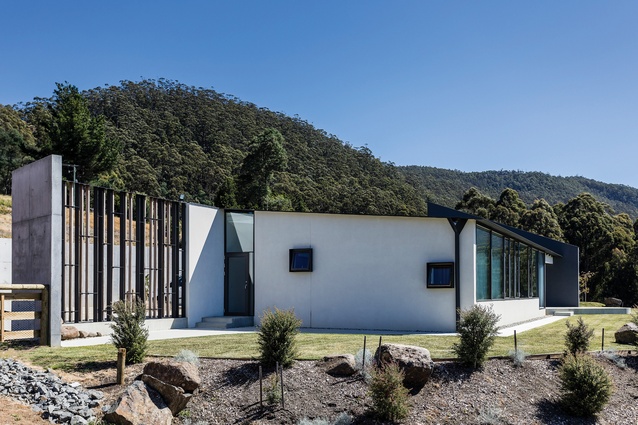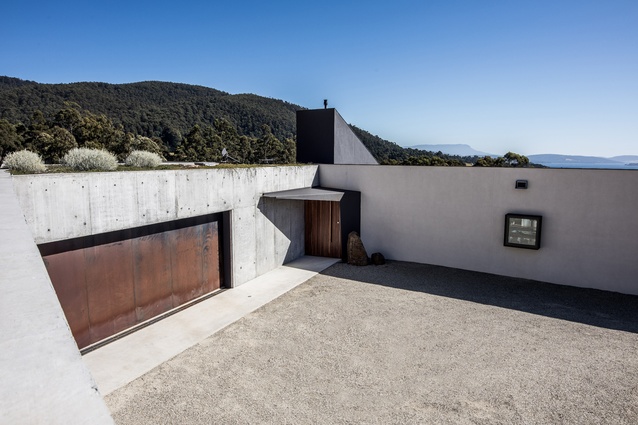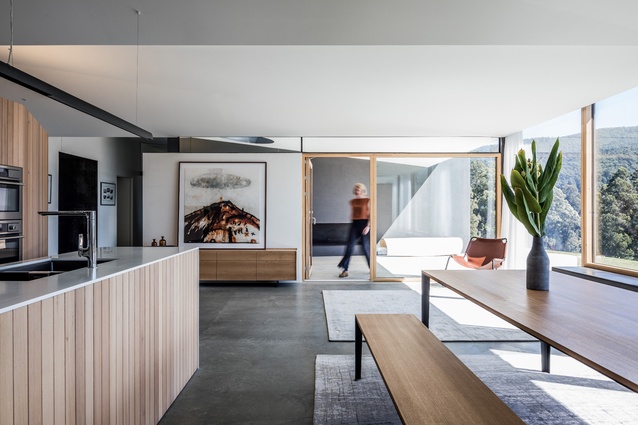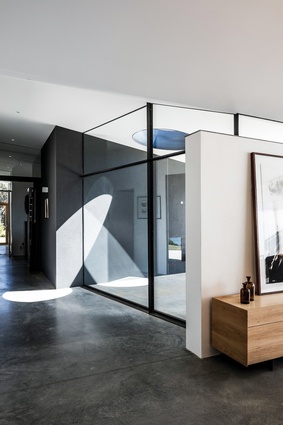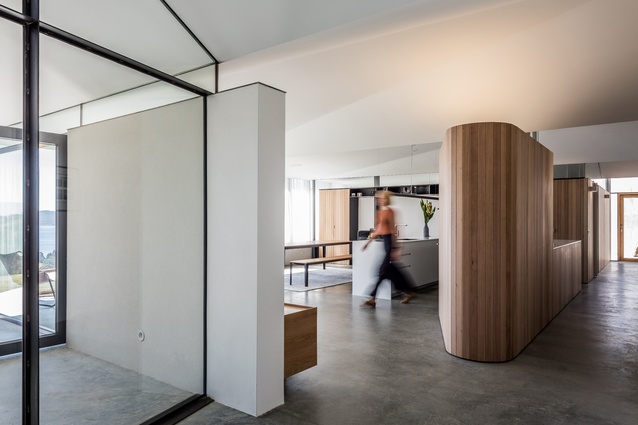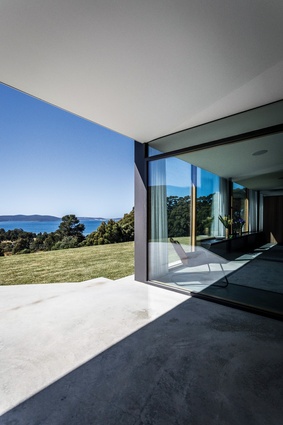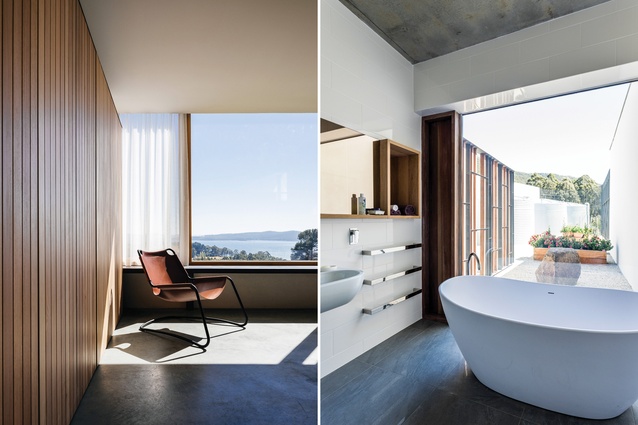Green haven: Sunnybanks House
With a simple, calm form nestled into the dramatic landscape of southern Tasmania, this “forever house” embraces sustainable design principles.
Contemplating migrating to Tasmania from Sydney, Andrew and Hilary Carpenter were looking for a place in the country that could become a refuge for their retirement. While scoping sites they were also researching ideas for building systems and materials for their new home. In doing so, they met Ryan Strating from Hobart-based architecture practice Core Collective Architects at a building expo in Sydney. They began discussing the pros and cons of different places to live in Tasmania, and Ryan agreed to assist them to look for a site. He found the perfect spot fifty minutes’ drive south of Hobart, on a site that overlooks the D’Entrecasteaux Channel toward Bruny Island.
Andrew and Hilary had built houses previously, without working with an architect, but they recognized the expertise that architectural services would offer their latest project. In particular, they were interested in building and living sustainably and were keen to explore low-maintenance strategies and materials. Over the next three and a half years they worked collaboratively with Core Collective to design and build their “forever house.”
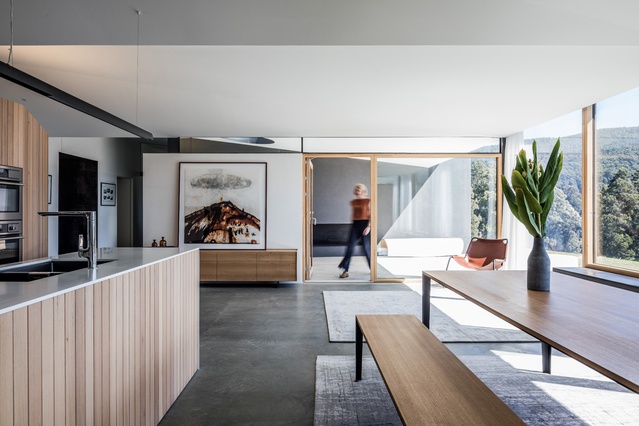
Andrew and Hilary brought with them ideas collected from previous building experiences and also a clear aesthetic sensibility that was influenced by their love of the cover art on a selection of their favourite albums and CDs. They were keen to capture a particular attitude to light and landscape and a general atmospheric condition that they admired about these images, which they have had framed and put on display in the living room, rather than leaving them tucked, unseen, in storage shelves.
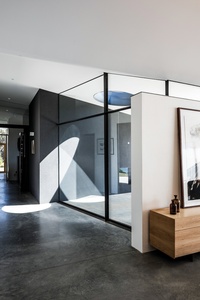
A simple linear plan was developed that allows the house to nestle in the north-facing slope, creating a perch from which to view the landscape. The sectional arrangement cleverly disguises the steepness of the slope: garages are tucked to the south against a full-height retaining wall and the living spaces open onto a flat plateau of lawn. A green roof over the garage is planted with Tasmanian native species, camouflaging the building from the road and retaining the view across the site. The roof of the main house slopes away from the road, so that it is also not visible, and this disguises the scale of the house on approach.
The house is oriented east–west across the slope, maximizing solar access through the triple-glazed northern wall, with the concrete floor acting as a solar sink to store the warmth of the winter sun. Adjustable openings to the north and south provide cross-flow ventilation for cooling when needed. Double-skin, insulated masonry walls in ClinkaBlok (made from lightweight, fired-clay aggregate ceramic balls mixed with cement, sand and water) form the remainder of the building envelope, and a bed of ClinkaFill (made from expanded clay aggregate) provides a layer of insulation under the concrete slab and around its edges.
The combination of passive design principles and high-thermal-performance construction has enabled a 9-star energy rating. Other elements of the house also embrace sustainability best practice: rainwater from the roof is collected for use, solar power is provided by a 5 kW photovoltaic system and on-site, gravity-fed waste treatment filters recycled water down the slope to irrigate the garden.
In response to the often-changeable weather, two external living spaces offer shelter from the wind but embrace the sun. A terrace is slotted into the length of the building, directly opposite the main entry, with a large circular void in the roof bringing natural light into the centre of the building plan. A fireplace/barbecue is built into the western edge, with glazing on the eastern edge extending the living room into the sheltered outdoor space.
The terrace extends beyond the building to create a favoured seating place that overlooks the landscape. To the south an enclosed courtyard expands the driveway entry court to create a space that is perfect for a neighbourhood jazz festival, a dramatic backdrop with sharp acoustics and subtle lighting.
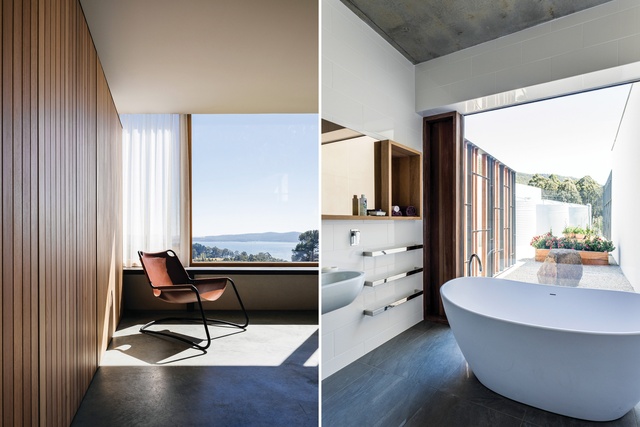
Both inside and out, the simple form is punctuated by custom-designed steel elements that were developed through working closely with steel fabricator Mike McGlynn of Allports. Externally, mild steel flat bars were used for screens and gates. A steel eave with integrated rain heads runs around the perimeter of the house, concealing the gutter and creating a fine edge. Folded steel forms the entry canopy over the front door, a low window seat along the front of the living space and joinery in the study.
The simplicity of the form provides a calm backdrop for life and creates a strong connection to the broader landscape. Internally, the rake of the skillion roof is distorted through the folding of the ceiling plane along a different geometry. This produces a subtle shift that creates a stronger sense of spatial balance than would have been afforded by an unadorned mono-pitched roof. Throughout the house the sequence of spaces results in a loose fit that can accommodate different social configurations, each nested calmly within the warm, bright interior overlooking the expansive view.
This article was first published in ArchitectureAU.com.

